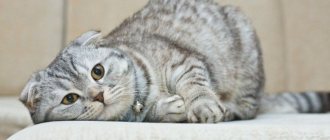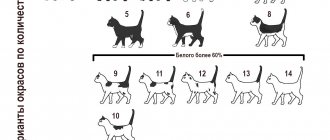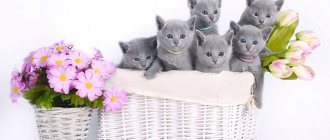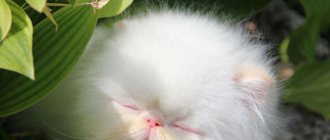Features of the development of six-month-old kittens
The developmental characteristics of kittens at 6 months vary significantly depending on the breed, living conditions and quality of care. Most outbred cats, at six months of age, are sexually mature, the cats begin to mark, and the cats are ready for mating. With purebred animals the situation is slightly different; six months of age is considered the threshold at which sexual formation begins.
A six-month-old kitten does not yet have enough skills to be considered an adult animal, but it is no longer a child either.
- By the age of 4–5 months, 40% of kittens develop lactose intolerance, which indicates that they are ready to fully transition to adult food.
- At the age of 6–7 months, the first molt occurs, during which the kitten gets rid of baby fluff and acquires adult hair, and if winter is ahead, also undercoat.
The diet of a 6-month-old kitten should be made taking into account all physiological needs: active bone growth, the final stage of eruption of chewing molars, the formation of an adult coat, more aggressive intestinal microflora and taste preferences that the pet will adhere to for the rest of its life.
Origin story
The only significant difference between Scottish Straight cats and Scottish Fold cats is in the ears. They are not curved, but straight - that’s the whole difference. These cats appeared in the 60s of the last century on an ordinary Scottish farm, and initially the cats’ ears were folded. Breeders, having started breeding a new breed, quickly found out: in litters, both kittens with curled ears and normal ones are usually born, and in addition, the gene responsible for the lop-eared gene negatively affects the health of animals.
The cats' bones thickened, early osteochondrodysplasia appeared, and they died early. Through trial and error, it became clear: the best option for crossing is a cat with straight ears and a fold-eared cat.
The Scottish Straight breed was officially registered in 2004 and immediately became extremely popular.
A kitten not for breeding costs about 5,000 rubles (without documents) and 10,000 rubles with documents. Show-class specimens will cost 18-25 thousand rubles.
What to feed a 6 month old kitten
If you become the owner of a six-month-old kitten, it is advisable to find out what he was fed before moving into your home. If such information is not available, for example, you bought a kitten at a poultry market or picked it up on the street, you need to create a diet based on the urgent needs at the moment.
When deciding what to feed your kitten, you need to choose between three basic options:
- Natural feeding.
- Industrial feeding.
- Mixed feeding
Mixed feeding is not recommended by veterinarians and prepared food manufacturers, although it is practiced by thousands of owners. Mixed feeding involves preparing a diet from ready-made feed and natural products.
Typically, the cat receives ready-made food for breakfast and food prepared from natural products for dinner.
A mixed type of feeding is a direct path to dysbiosis, and this, in turn, is the first reason for inadequate absorption of food.
Natural products
A natural diet is considered more natural for a cat, however, when preparing it, it is necessary to take into account the peculiarities of physiology. When developing a menu, you need to rely on one of three methods of natural feeding:
- Raw and cooked foods, pure and mixed.
- Exclusively raw products.
- Semi-finished products from natural homemade products.
Health
Characteristic diseases
The handsome Scottish Fold cat attracts with his ears, however, such beauty is expensive for his health.
Research has shown that pinched ears are a gene mutation. It causes a skeletal abnormality in the animal, resulting in osteochondrodystrophy and frequent rickets in kittens.
The disease is accompanied by severe pain and often leads to disability of the pet.
Unfortunately, veterinary medicine has not yet found a way to eliminate the mutation gene.
Advice: when buying a kitten, touch its paws and tail - lethargy or stiffness in their mobility indicates the presence of the disease described above. It is impossible to cure an animal, keep this in mind.
We have already talked about drafts, and this is no coincidence. Scottish Folds quickly catch bronchitis if there is wind in the house.
The weak point of the breed and slightly bulging eyes. Make sure they don't tear.
Frequent tearing can cause nasal congestion and affect the general condition of the animal.
In general, fold-eared cuties are quite hardened creatures, with good immunity.
The Scots are very clean
Another disease of the breed is hemophilia. Blood clotting is so impaired that even with a small cut the bleeding does not stop for a long time.
The disease also has no cure; the doctor can only prescribe symptomatic therapy.
Vaccinations
its first comprehensive vaccination from the breeder and is carried out at 2 months. Then the owner is responsible for vaccinating the animal.
For a Scottish Fold cat, the same procedure and set of vaccinations is used as for any other breed.
Once a year, the animal must receive a vaccine against plague, hepatitis, rabies and other viral diseases.
This could be Nobivak Trikat, Quadrikat, or Multifel-4. Don’t forget to deworm your pet 10 days before vaccination (removal of worms).
Cats sleep most of the day
Feeding mode
For normal growth and development of a kitten, it is extremely important to adhere to the feeding regime and correctly calculate the amount of food needed to compensate for basic physiological needs. To be sure that you do not overfeed the kitten, the serving size must be calculated using the following algorithm:
- Calculate the daily feed intake based on caloric content and protein content.
- Divide the daily feed amount by the number of feedings.
At the age of 6 months, kittens become active at certain times of the day. After a period of activity, the kitten should receive a full portion of food; if the baby just woke up or got hungry while resting, a snack will be enough. In total, during the day, the kitten should eat 4-5 times and have a snack 1-2 times.
Formative nutrition: from the first month to six months
Now all the sleepless nights are over and your kittens begin to confidently stand on their feet, get out of the nest, bully each other, run to the kitchen in search of food - in a word, the body has survived and its active formation has begun. During this period, the main body weight gain occurs. Every day the kitten asks for more and more food, sometimes it becomes capricious, turns up its nose, and sometimes it devours the entire portion; all you have to do is replenish the bowl.
At this age, breeders should provide the baby with food in sufficient quantities so that he always has enough energy for development and play. In addition to calories, during this period of life a kitten needs to consume all the building material from which its body will be formed, and, consequently, its future health. To do this, breeders begin gradually feeding babies a wide variety of foods.
The calculation of the number of feedings during this period is still determined by weight. Now 1 kg is taken as a basis. The daily dose for a kilogram kitten is 150-250 grams of a balanced diet. This means that your daily intake should include proteins, vegetables, cereals and fermented milk. Moreover, in the first month their ratio will be more towards liquid mixtures, and by the fifth month the diet should already contain more meat products. The most common scheme looks like this:
- 1st and 2nd months - 5 meals a day: every 4 hours, skipping one night feeding (break 8 hours);
- 3rd and 4th months - 4 meals a day: every 4 hours, skipping two night feedings (12 hour break);
- 5th and 6th months - 3 feedings per day.
Although the kitten eats less and less every month, this does not mean that it needs to be fed less and less. In no case! On the contrary, now is the time to eat a lot, even more adult cats. It’s just that now the portion size should increase, since the kitten’s stomach expands every day. It is no longer a problem for your baby to fit the right amount of food into it at one time. In the morning, it is advisable to give fermented milk, in the afternoon - mixtures of cereals, vegetables and meat, in the evening - meat products (so that the hunter sleeps at night and does not look everywhere for the treasured game).
Water in a kitten's diet
Water plays a fundamental role in metabolism and the process of hematopoiesis. Thick blood makes it difficult for all organs to function and slows down metabolism. If the water-salt balance is disturbed, and this is possible if the kitten does not receive enough water, the pet grows or develops untimely.
To avoid health problems, make sure your kitten has easy access to water. If necessary, place several additional drinking bowls in your home, but do not forget to regularly change the water in them. The water must be fresh, because if it sits in a bowl for 10–12 hours, bacteria will begin to multiply in it, and this is one of the causes of indigestion and problems in the gastrointestinal tract.
Vitamins and supplements
When kept on high-quality, industrial feed, vitamins and additives are not required. It is important to understand that an excess of vitamins and microelements is no less dangerous than their deficiency. With a natural feeding method, vitamin supplements should be present in the diet on an ongoing basis at least until the age of one year.
A kitten can get basic vitamins and nutrients from natural products:
- Meat and bone meal.
- Fish, chicken, beef liver.
- Greens, vegetables, fruits.
- Sunflower oil, olive oil.
- Brewer's yeast.
Ready-made feed
The opinions of veterinarians regarding which food to prefer - natural or ready-made specialized food - do not coincide. The main advantage of ready-made food is that there is no need to introduce special complementary foods, as with natural nutrition, since it already contains fortified supplements. But there is also a significant drawback - the addition of flavors and preservatives, which can harm the health of babies.
If you decide to feed your pet prepared food, you need to remember the rules:
- Do not mix dry and wet food together;
- stick to a particular brand of food and change it only if absolutely necessary.
When choosing ready-made food, you need to carefully study the products of manufacturing companies. Find out whether it is possible to use their food, combine dry and wet canned food, and in what quantity to give them. According to veterinarians’ recommendations, from four months onwards, a kitten can be given the entire daily portion at once: it already knows how to control the amount of food it eats. It is better to pour wet canned food in sauce and jelly in the quantity required for a single meal. In case of a possible combination, the daily diet of a pet, according to the recommendations of experts, should consist of 3 quarters of dry food and 1 quarter of canned food.
Without causing harm to the baby’s health, you can use the following foods:
Acana
One of the best proven super premium food series. It provides a complete balanced diet and is the best hypoallergenic food. The food is produced in its own juice. The composition includes only whole and fresh ingredients. It contains meat ingredients, vegetables, fruits, seaweed, fresh eggs, polyunsaturated fats, proteins and proteins in optimal quantities.
Royal Canin
Dry food from this company is the best substitute for natural food, as it contains the substances necessary to maintain the life and activity of a kitten. The brand’s “medicinal” line is especially popular. The composition of veterinary feeds from this company is ideally balanced and takes into account the characteristics of a particular disease. Suitable food for kittens aged 4-12 months.











